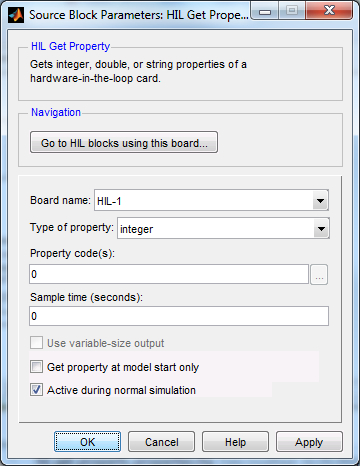

HIL Get Property
Gets numeric or string properties of a hardware-in-the-loop card.
Library
QUARC Targets/Data Acquisition/Generic/Configuration MATLAB Command Line Click to copy the following command line to the clipboard. Then paste it in the MATLAB Command Window: qc_open_library('quarc_library/Data Acquisition/Generic/Configuration')
Description

The HIL Get Property block gets integer, double, or string properties for a specified HIL card. This block can get more than one property at a time if the properties are integer or double properties. The properties are set at each sampling instant of the block, or only once when the model starts.
Input Ports
This block has no input ports.
Output Ports
value
The value of the property or properties. For string properties, if the Use variable-size output option is checked then the output is a variable-size signal. Refer to Variable-Size Signals for more information on variable-size signals.
Parameters and Dialog Box

Board name
The name of the board whose properties will be retrieved. Boards are configured using the HIL Initialize block. Place an HIL Initialize block in your diagram to add a board name to the list.
Type of Property
This combo box allows the user to select the type of property to be retrieved. The three property types are integer, double, and string.
See the documentation for your HIL card for details on the available properties, property types, property codes, and valid values.
Property code(s)
This field specifies the code of each property that will be retrieved. For integer and double property types, multiple property codes can be specified.
For the string property type, only one property code may be retrieved by each HIL Get Property block.
Sample time
The sample time of the block. A sample time of 0 indicates that the block will be treated as a continuous time block. A positive sample time indicates that the block is a discrete time block with the given sample time.
A sample time of -1 indicates that the block inherits its sample time from the input. The sample time must be inherited when the block is placed in a conditionally executed subsystem like the Triggered Subsystem block.
To set the sample time to the fundamental sampling time of the model, use the qc_get_step_size function, which is a QUARC function that returns the fundamental sampling time of the model. The fundamental sampling time of the model is the sampling time entered in the Fixed step size field of the Solver pane of the Configuration parameters.
Use variable-size output
Enabling this option causes the value output to be variable-size. In this case, the size of the output varies dynamically with the size of the string property. If this option is not checked then the output is a fixed-size vector. Refer to Variable-Size Signals for more information on variable-size signals.
This option is only enabled for string properties.
Get property at model start only
When this option is checked, the properties will be retrieved only once when the model is started. Otherwise, the properties will be retrieved at each sampling instant.
Targets
|
Target Name |
Compatible* |
Model Referencing |
Comments |
|---|---|---|---|
|
Yes |
Yes |
||
|
Yes |
Yes |
||
|
Yes |
Yes |
||
|
Yes |
Yes |
||
|
Yes |
Yes |
||
|
Yes |
Yes |
||
|
Yes |
Yes |
||
|
Yes |
Yes |
||
|
Yes |
Yes |
||
|
Yes |
Yes |
||
|
Yes |
Yes |
||
|
Yes |
Yes |
||
|
Yes |
Yes |
||
|
Yes |
Yes |
Last fully supported in QUARC 2018. |
|
|
Rapid Simulation (RSIM) Target |
Yes |
Yes |
|
|
S-Function Target |
No |
N/A |
Old technology. Use model referencing instead. |
|
Normal simulation |
Yes |
Yes |
See Also

Copyright ©2025 Quanser Inc. This page was generated 2025-11-01. Submit feedback to Quanser about this page.
Link to this page.